Canter in the horse (Single suspension, transverse)
The canter is similar but not identical to a slow gallop.
In the gallop, each of the four feet touch down and push off
individually - non-lead hind, lead hind, non-lead fore, lead fore,
suspension. In an ideal canter, the lead hind and non-lead fore
touch down together and push off together. This horse is very close
to that ideal. Very strung-out, uncollected horses moving slowly
with the center of gravity well forward are most likely to touch down
with the non-lead forefoot before the lead hind foot hits the ground,
while extremely collected animals with the center of gravity well
back may have the gallop footfall sequence.
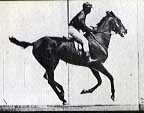
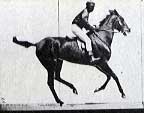
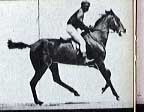 These three photos show the initial touchdown of the
non-lead hind foot, (Frames 1 and 2) and the full weignt-bearing
phase with support by the non-lead hind. Note pastern flexion
between 1 and 3.
These three photos show the initial touchdown of the
non-lead hind foot, (Frames 1 and 2) and the full weignt-bearing
phase with support by the non-lead hind. Note pastern flexion
between 1 and 3.
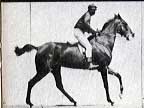
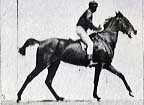
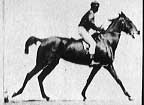 3-legged support (left) lead hind and non-lead fore
touching down and carrying the weight. From the difference in
pastern flexion, I would say the foreleg is touching down slightly
before the diagonal rear. Center and right frames show 2-legged
support on the diagonal.
3-legged support (left) lead hind and non-lead fore
touching down and carrying the weight. From the difference in
pastern flexion, I would say the foreleg is touching down slightly
before the diagonal rear. Center and right frames show 2-legged
support on the diagonal.
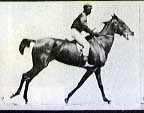
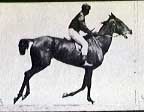
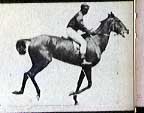 Pushoff phase from lead rear and non-lead fore (left),
with pushoff from fore slightly ahead of that from rear, as in
landing. Two right frames correspond to the vaulting phase, with
one supporting leg, in the gallop. Note that any phase when both
forelegs bear weight is very brief.
Pushoff phase from lead rear and non-lead fore (left),
with pushoff from fore slightly ahead of that from rear, as in
landing. Two right frames correspond to the vaulting phase, with
one supporting leg, in the gallop. Note that any phase when both
forelegs bear weight is very brief.
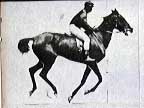
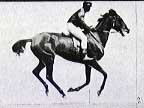
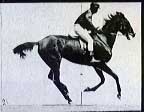 Suspended phase, right frame just before touchdown by
non-lead rear.
Return to Animal motion index
Suspended phase, right frame just before touchdown by
non-lead rear.
Return to Animal motion index














